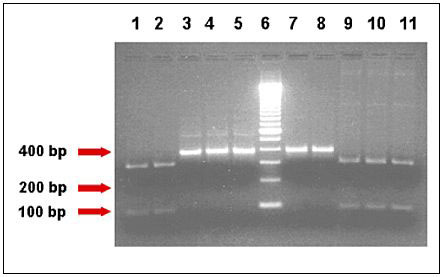Volume 4, Number 4—December 1998
Dispatch
Differentiating Human from Animal Isolates of Cryptosporidium parvum
Figure

Figure. Human- and bovine-specific restriction enzymes showed distinct banding pattern for genotypes of Cryptosporidium parvum isolates. The different lanes represent the TRAP-C2 PCR-amplified products belonging to AGA43, AMD36, AOH6, HM3, and HM5 isolates of C. parvum, respectively, after digestion with HaeIII (Lanes 1-5, human-specific marker) and BstE II (Lanes 7-11, bovine-specific marker) restriction enzymes and agarose gel electrophoresis. Lane 6 is the 100 bp marker. Samples AGA43, AMD36 and AOH6 are bovine (bovine genotype) and samples HM3 and HM5 are human (human genotype). Human- or bovine-specific restriction enzyme markers can cut only the TRAP-C2 amplified product of the respective genotype of C. parvum isolates.
Page created: December 16, 2010
Page updated: December 16, 2010
Page reviewed: December 16, 2010
The conclusions, findings, and opinions expressed by authors contributing to this journal do not necessarily reflect the official position of the U.S. Department of Health and Human Services, the Public Health Service, the Centers for Disease Control and Prevention, or the authors' affiliated institutions. Use of trade names is for identification only and does not imply endorsement by any of the groups named above.